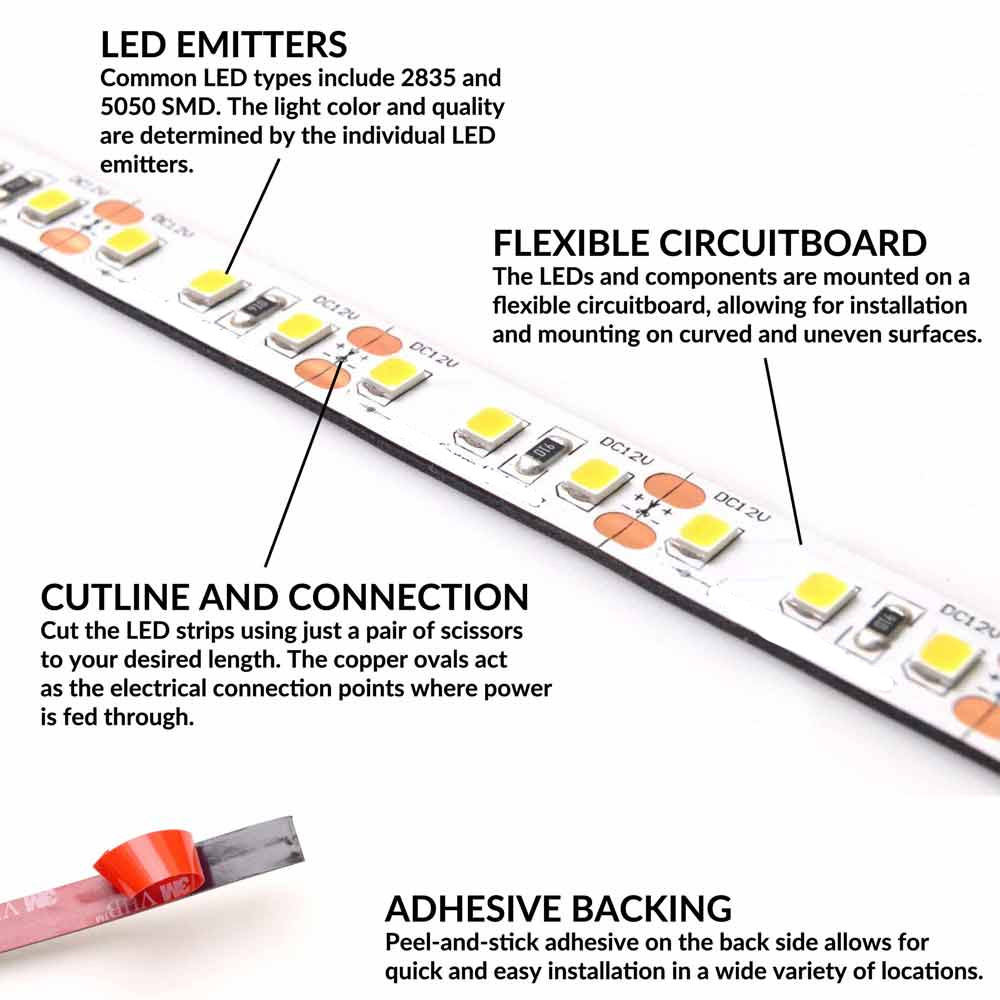EVERYTHING YOU NEED TO KNOW BEFORE YOU BUY
What is an LED Strip Light?
LED strip lights are new and versatile forms of lighting. There are many variants and exceptions, but for the most part, they have the following characteristics:
- Consist of many individual LED emitters mounted on a narrow, flexible circuitboard
- Operate on low-voltage DC power
- Are available in a wide range of fixed and variable color and brightness
- Ship in a long reel (typically 16 feet / 5 meters), can be cut to length, and includes double-sided adhesive for mounting

Anatomy of an LED strip
An LED strip light is typically half an inch (10-12 mm) in width, and up to 16 feet (5 meters) or more in length. They can be cut to specific lengths using just a pair of scissors along the cutlines, located every 1-2 inches.
Individual LEDs are mounted along the strip, typically at densities of 18-36 LEDs per foot (60-120 per meter). The light color and quality of the individual LEDs determine the overall light color and quality of the LED strip.
The backside of the LED strip includes pre-applied double-sided adhesive. Simply peel off the liner, and mount the LED strip to virtually any surface. Because the circuitboard is designed to be flexible, LED strips can be mounted on curved and uneven surfaces.

Determining LED Strip Brightness
Brightness of LED strips is determined using the metric lumens. Unlike incandescent bulbs, different LED strips can have different levels of efficiency, so a wattage rating is not always meaningful in determining actual light output.
LED strip brightness is typically described in lumens per foot (or meter). A good quality LED strip should provide at least 450 lumens per foot (1500 lumens per meter), which provides approximately the same amount of light output per foot as a traditional T8 fluorescent lamp. (E.g. 4-ft T8 fluorescent = 4-ft of LED strip = 1800 lumens).
LED strip brightness is primarily determined by three factors:
- Light output and efficiency per LED emitter
- The number of LEDs per foot
- The power draw of the LED strip per foot
An LED strip light without a brightness specification in lumens is a red flag. You will also want to watch out for low cost LED strips that claim high brightness, as they may overdrive the LEDs to the point of premature failure.
LED Strip Color Options: White
LED strip lights are available in various shades of whites or colors. Generally, white light is the most useful and popular option for indoor lighting applications.
In describing the different shades and qualities of white, color temperature (CCT) and color rendering index (CRI) are two metrics that are important to keep in mind.
Color temperature is a measure of how “warm” or “cool” the light’s color appears. The soft glow of a traditional incandescent bulb has a low color temperature (2700K), while the crisp, bright white of natural daylight has a high color temperature (6500K).
Color rendering is a measure of how accurate colors appear under the light source. Under a low CRI LED strip, colors might appear distorted, washed out, or indistinguishable. High CRI LED products offer light that allows objects to appear the way they would under an ideal light source such as a halogen lamp, or natural daylight. Also look for a light source’s R9 value, which provides further information about how red colors are rendered.
Need help deciding which color temperature to choose? See our tutorial here.
Adjust the sliders below for a visual demonstration of CRI vs CCT in action.
How to Connect LED Strips
Each LED strip segment must be connected to a DC power supply, or another LED strip segment that is connected to a DC power supply (daisy chain). The connection method will depend on the type of wires or plugs provided with the LED strip, as well as whether or not the DC power supply includes a plug. If you are familiar and comfortable with soldering, oftentimes this can provide the most cost effective and flexible solution.
Not sure how or don’t want to deal with solder? You can also use solderless connector accessories to connect LED strip segments to power supplies and other LED strip segments.

 Taicron Lighting
Taicron Lighting
